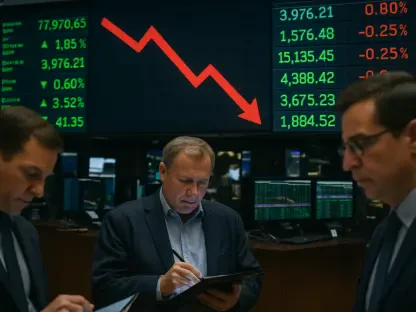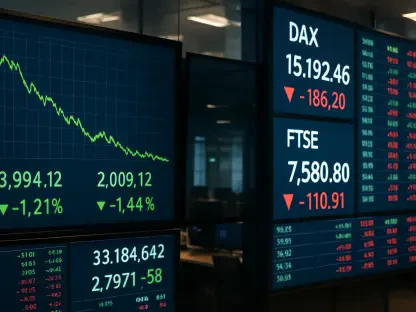Welcome to an insightful conversation with Priya Jaiswal, a renowned authority in banking, business, and finance. With her deep expertise in market analysis, portfolio management, and international business trends, Priya offers a unique perspective on the latest developments shaking up Wall Street. In this interview, we dive into the sharp reversal of major indexes, the pivotal role of the tech sector, the impact of recent economic data, and what investors can expect in the near future. Let’s explore the forces driving the markets and what they mean for the broader economy.
Can you walk us through what unfolded on Wall Street this past Thursday with the major indexes?
Absolutely, Thursday was quite a rollercoaster. We saw the Dow, S&P 500, and Nasdaq start the day with a promising rally, fueled by optimism around certain earnings reports. However, that momentum reversed sharply, with the Dow dropping 0.8%, the S&P 500 falling 1.6%, and the Nasdaq sliding 2.2% by the close. The Nasdaq even hit its lowest point since mid-September. This kind of abrupt shift often points to underlying nervousness among investors, where initial enthusiasm gets quickly overshadowed by broader concerns or profit-taking.
What caused such a dramatic swing in the indexes, particularly with the Nasdaq and Dow moving over 1,000 points from high to low in a single day?
The swing was indeed striking— the Nasdaq saw a nearly 5-percentage-point difference between its peak and trough, the biggest intraday move since early April. The Dow wasn’t far behind in terms of volatility. This kind of whipsaw action typically reflects a clash between short-term optimism and deeper uncertainties. Early gains were likely driven by specific catalysts like earnings surprises, but as the day progressed, broader worries—perhaps about valuations or economic data—prompted a wave of selling. It’s a classic sign of fragile sentiment.
How does this reversal reflect on investor confidence at the moment?
It’s a clear signal that confidence is shaky. When you see markets rally and then collapse within hours, it suggests investors are quick to lock in gains or cut losses at the slightest hint of trouble. There’s a defensive posture in play, as evidenced by sectors like consumer staples being the only gainers while tech took a beating. This behavior often indicates fear of overvaluation or uncertainty about economic policies and data, making the market hypersensitive to any negative cues.
Let’s shift to the tech sector, which seemed to lead the decline. What’s behind the struggles in this space?
Tech stocks were at the heart of Thursday’s drop, largely because they’ve been riding high for so long, and investors are increasingly questioning whether current valuations are sustainable. There’s particular concern about the massive spending on artificial intelligence—while it promises future growth, the costs are steep right now. When early gains in major tech names reversed, it dragged down the Nasdaq significantly, showing how reliant the index is on this sector’s performance.
Can you elaborate on why Nvidia, despite strong earnings, couldn’t hold onto its early gains?
Nvidia’s case is fascinating. They reported earnings that beat expectations and forecasted robust sales for the fourth quarter, which initially sent their stock up 5%. However, it ended the day down 3.2%. I think the market’s reaction reflects broader skepticism about whether the AI boom can justify current stock prices across tech. Even with positive news, investors seem to be taking a “sell on the news” approach, worried that the growth might not keep pace with expectations or spending levels.
How are other chip companies holding up, and what does the nearly 5% drop in the semiconductor index tell us?
It’s not just Nvidia—most chip-related companies felt the heat, with the semiconductor index falling 4.8%. This suggests the concern isn’t company-specific but industry-wide. Investors are likely reassessing the entire sector’s growth trajectory, especially given the high costs of innovation and production. A drop of this magnitude in the index points to a potential cooling-off period for semiconductors, as the market grapples with whether recent gains were overblown.
Turning to the recent jobs data, how did the September report influence market sentiment on Thursday?
The jobs report added another layer of complexity. It showed the unemployment rate ticking up in September, which was a red flag, even though job additions exceeded forecasts at 119,000 against an expected 50,000. This mixed picture muddied the waters for investors, as it raised questions about the labor market’s true health. With this being the last major jobs data before the Federal Reserve’s December meeting, it likely contributed to the day’s volatility as traders debated the odds of another rate cut.
How does this jobs data shape expectations for the Federal Reserve’s next moves?
The mixed signals from the report create a dilemma for the Fed. On one hand, stronger-than-expected job growth might suggest the economy doesn’t need immediate stimulus. On the other, a rising unemployment rate could push for a rate cut to support growth. Right now, the market seems split on whether we’ll see a cut in December. This uncertainty is a big factor weighing on investor decisions, as Fed policy heavily influences market direction.
There’s also talk of a flood of economic data on the horizon. Can you explain what’s causing this delay in reports?
Yes, we’re seeing delayed economic reports due to a record 43-day government shutdown that only ended last week. This has backlog issues with critical data releases, including jobs numbers. Normally, we’d have monthly updates, but now we’re playing catch-up. The upcoming combined October and November jobs reports will be crucial, as they’ll give us a clearer picture of the labor market over a longer stretch, potentially amplifying their impact on markets.
Looking ahead, what’s your forecast for how these upcoming economic reports might shape market trends?
I think these reports could be a make-or-break moment for market sentiment. If the combined October and November data show consistent weakness in the labor market, we might see renewed calls for Fed intervention, which could boost stocks temporarily. However, if the numbers are stronger than expected, it might ease pressure on the Fed to cut rates, potentially leading to more selling in overvalued sectors like tech. Either way, volatility is likely to stick around as investors digest this wave of information.









